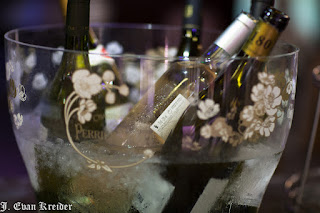When we were in Lyon, the Bloughs recommended that we stay at the ibis hotel that was perhaps three blocks from the train station (the newer one built especially for the TVG or 'trains of great speed'). The price was good for a large city (€78/night + €9 for a very hearty breakfast). The room was tiny, but I was able to watch the Champions League final football game from Milan after dinner, so all was well.
The added attraction was that the hotel would be right across the street from the city's famous covered market, Les Halles Paul Bocuse. I mentioned earlier that I have used one of his cookbooks. I liked him because he tried to get away from the heavy sauces (made famous in English-speaking countries through Julia Child's efforts). Instead, he emphasized good quality food done more simply. He would later criticize the fanciful piling up of exotic foods on plates, saying that chefs were neglecting taste for presentation. In my opinion, he was and is right. The restaurants we frequented in Lyon were not top-flight, so presentation was truly secondary, but tastes were just fine.
I left the bit of car in lower right corner of the photo because the "B" on the license plate indicates that the car is registered in Belgium and the dealership on the tag indicates that it is not far south of Brussels.
You immediately encounter displays of all kinds of sausage and cuts, many of which were new to me. It would be fascinating to learn to know the differences, and I clearly had not done my research in advance.
This counter specialized in various cuts of lamb.
The Alsatian counter had all sorts of delights we have learned to enjoy from our visits there and from an Alsatian shop that used to be near where we lived in Paris for a year. Their simple but colourful illuminated stained/painted glass is eye-catching.
Time to list some of the sausages identified here by label (left to right; the kg is about 2.2 pounds, and the Euro is now about US$1.12):
- Saucisse au poivre vert (€27.40/kg) An Alsatian (and elsewhere) sausage of minced pork, including some loin if the quality is tops, all ground together with green pepper corns.
- Saucisson sec pur porc (€19.90/kg) This 'pure pork' sausage and is very well cured (until 'dry'). This would be about 1/4 pork fat, the rest meat, no cereal added.
- Saucisson sec supérieur (€30.50/kg) Presumably uses better cuts of pork, but now I'm guessing.
- Saucisson à cuire pur porc (€15.30/kg) clueless on how this differs!
- Sabodet (€15.20/kg) Yet another pork sausage. This is to be cooked by you in water (or one writer suggests in wine), simmering it for at least an hour. It is to be left in the hot brine until served hot, and is to be cut in thick slices so that you get all the tastes (garlic, the differing cuts of pork, etc.) Since it is served hot, it is considered primarily a winter sausage, until of course the weather turns hot and people want it anyway . . . .
This table arrangement was so typical, with light wooden chairs, paper napkins (OK, we didn't splurge) and two glasses per person. In Lyon, the more squat glass seemed to be used for the water and the taller glass for the wine, but I try not to pour until I see the lay of the land.
Janice is bringing this paper place mat home, in case we need to memorize our various cuts of beef. I fear I cannot even name all of these cuts in English, and suspect that we may cut things differently. But I'm fairly certain that our local grocer doesn't offer this many options for cuts of beef.
Saucisson Jésus sec? OK, I had to take a photo, at least of the sign. Turns out that this unusual name comes from the time of year people most frequently eat it. I know you never served sausage as the main course for Christmas dinner, but wonder if some ancient ways of our ancestors have been forgotten. Perhaps not. In the olden days, people in this part of France would indeed save their very finest cuts of pork, ham, etc., and make them into one large (5 kg minimum) sausage for Christmas Day, or for Jesus, as they would say.
When I spot a tummy this size approaching any food counter, I immediately assume "this food must be good!" Or fattening. Maybe he never leaves?
You can also eat in the market at any of a number of counters, more for a quick lunch on a working day. We arrived at nearly 2 p.m., so the pressure was already off, but even so, we had to look around to find a table.
A number of restaurants are clearly prepared for visitors who will be using English when ordering, even if it is perhaps their fourth language. For instance, one evening we had supper, nearly surrounded by a group of 20+ people speaking a language we couldn't quite get. They were staying at our ibis, and a sign was posted for them by the elevator, we assume in their language. Janice looked up some words. Turns out they were likely from Iceland, but used English to order (and a touch of French).
I'm starting to sound like Dad, writing primarily about food, so I'll stop for now,
With love from us both,
Evan

















No comments:
Post a Comment